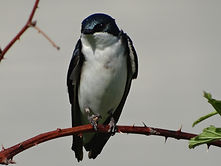
Research Program
My research program primarily seeks to answer two questions.
1. Why are birds brightly colored?
1. Why are birds brightly colored?
My research seeks to understand what what information is conveyed to conspefics by pluamge ornaments expressed in male and female songbirds. This research examines relationships between coloration and reproductive behaviors such as territoriality, parental care, and extra-pair mating. I am also interested in understanding how aspects of physiology are related to ornament expression and the role of hormones in mediating links between plumage coloration and reproductive behaviors. Further, I want to understand how variation in biotic and abiotic factors (both natural and anthropogenic) can influence coloration, physiology, and behaivor and what implications varaition in ecological factors may have for the strength and direction of selection.




2. How does variation in ecological factors influence physiology, development, and reproduction?
Animals must respond to variation in biotic (predators, parasites, competitors) and abiotic conditions (weather, nutrient availability, exposure to contaminants) of both natural and anthropogenic origins. My research examines how variation in these biotic and abiotic factors can influence reproductive success, offspring development, and physiology of adults and young. Ultimately, I am interested in how these factors could influence fitness and the potential ramifications for population persistance and growth. This research has important applied components given the current rate of global change. In addition to songbirds, my work in this area has involved collaborations with other scientists and focused on amphibians, reptiles, and mammals.






Current research
Melanin ornamentation, physiology, and behavior of song sparrows
The influence of Pb exposure on coloration and mate choice in zebra finches
Structural plumage coloration in tree swallows-relationships with immunity and female aggression
Dietary exposure to elements and their influence on physiology and reproduction in tree swallows
Plumage coloration, extra-pair mating, and reproductive investment in prothonotary warblers
Previous research
Dietary exposure to elements and their influence on physiology and reproduction in tree swallows
Plumage coloration, extra-pair mating, and reproductive investment in prothonotary warblers
Extra-pair mating and paternity assurance behaviors in house finches
Ecological conditions, maternal effects, and population divergence in house fiches